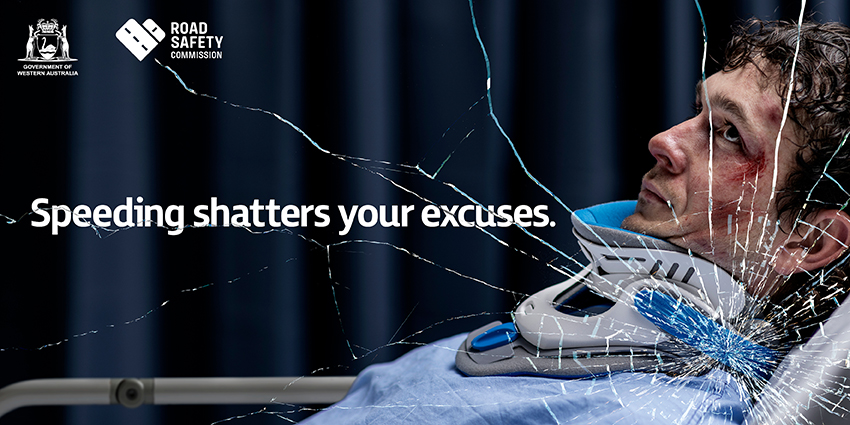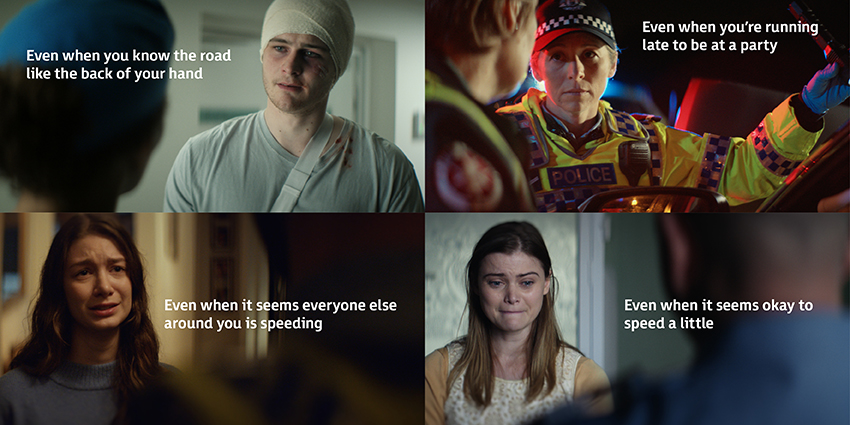Speeding
Nothing ever makes it okay to speed, it’s just not worth the risk. Speed limits are established to protect everyone on the road, and they are based on what is safe for the different types of roads and environments.
Speeding shatters your excuses.
Speed is still the biggest cause of fatalities and severe injuries on our roads. In 2023 alone, 41% of fatalities were in crashes in 110 km/h speed zones. Between 2018 and 2023, 1,787 people were killed or seriously injured in speed-related crashes.
The facts that shatter the excuses:
The faster you travel, the longer it takes to stop.
Small increases in speed sharply increases the risk of a pedestrian dying in a collision.
The faster you go, the harder you hit.
'I’m only going a little over the speed limit.'
For every 5km/h increase in travelling speed in a 60km/h zone, the risk of being injured in a crash doubles. At 65km/h the chance of having a crash resulting in injury doubles, it’s four times more likely at 70km/h and the risk increases by 32 times at 80km/h.
'I drive faster when I’m late, but not dangerously.'
It only takes a few kilometres over the limit to make the difference between stopping in time and having a fatal impact.
The Speeding shatters your excuses advertising campaign challenges the common excuses of speeding, relaying the message that nothing ever makes it okay to speed.
The distance you take to stop can make all the difference
Your stopping distance due to speeding could be the difference between someone escaping with little more than a scare and a pedestrian losing their life.
Reaction distance is the distance you travel between seeing a problem and hitting the brakes. If you’re doing 60km/h, you’ll still travel 25 metres in the time it takes for the message to get from your brain to your foot.
Braking distance is the number of metres you travel between hitting the brakes and coming to a complete stop. You’ll cover another 20 metres before this happens, assuming you’re driving on a dry road, in a newer car with good tyres and brakes.
Stopping distance is the distance when you add your reaction distance to your braking distance. If you’re doing 60km/h, you should come to a stop within 45 metres. If you are speeding, it is easy to see that 5km/hr over the speed limit, will greatly impact your ability to brake in time to avoid a crash.
Reducing your speed for the conditions
There will also be times when it is safer to adjust your speed down from the posted limit to accommodate for conditions such as rain, traffic density, loose surfaces, low light and poor visibility.
The Physics of Speed
Take the Physics of Speed simulation challenge and test your driving skills against the laws of physics.
Offences and Penalties
Show moreSee our Double Demerit information for more.
Speeding by light vehicles
Cars, motorcycles, and other vehicles less than 22.5 tonnes Gross Combination Mass.
| Km/h over the speed limit | Penalty | Demerits |
|---|---|---|
| Not more than 9 km/h | $100 | 0 |
| More than 9km/h but not more than 19 km/h | $200 | 2 |
| More than 19 km/h but not more than 29 km/h | $400 | 3 |
| More than 29 km/h but not more than 40 km/h | $800 | 6 |
| More than 40 km/h | $1,200 | 7 |
Speeding by heavy vehicles
Vehicles with a Gross Combination Mass of 22.5 tonnes or more.
| Km/h over the speed limit | Penalty | Demerits |
|---|---|---|
| Not more than 9 km/h | $200 | 0 |
| More than 9km/h but not more than 19 km/h | $300 | 2 |
| More than 19 km/h but not more than 29 km/h | $500 | 3 |
| More than 29 km/h but not more than 40 km/h | $1,200 | 6 |
| More than 40 km/h | $1,500 | 7 |
Radar Detector and Speed Camera Evasion Equipment
Show moreDriving with a radar detector fitted to, within or on the vehicle – operational or not
| Offence | Penalty | Demerits |
|---|---|---|
| Driving a heavy vehicle. | $1,500 | 7 |
| Driving a motor vehicle other than a heavy vehicle. | $1,200 | 7 |
Driving with any device that would adversely affect speed measuring equipment
| Offence | Penalty | Demerits |
|---|---|---|
| Driving a heavy vehicle | $1,500 | 7 |
| Driving a motor vehicle other than a heavy vehicle | $1,200 | 7 |
Driving in a manner that would adversely affect speed measuring equipment
| Offence | Penalty | Demerits |
|---|---|---|
| Driving a heavy vehicle | $1,500 | 7 |
| Driving a motor vehicle other than a heavy vehicle | $1,200 | 7 |
Average Speed Safety Camera Zone
Show moreHow does it work?
Let’s say a speeding driver is heading towards the Safety Camera Zone. Once the driver enters the zone, a camera will record an image of the vehicle. Another image will be taken when the vehicle exits the zone. These images measure the vehicle’s:
1) Entry speed
If the vehicle exceeds the posted speed limit at this point, a speeding infringement may be issued;
2) Exit speed
If the vehicle exceeds the posted speed limit at this point, a speeding infringement may be issued, and;
3) Average speed between the two cameras
If the vehicle’s average speed exceeds the posted speed limit, a speeding infringement may be issued.
If you are caught speeding in the zone, you will receive at least one infringement. However, a decision on enforcement will be made by WA Police based on the nature of the speeding offence.
Saving lives
Speeding increases the chances of a crash, as well as the likelihood of serious injury or death in a crash. Our research shows that speed cameras make drivers slow down, help reduce the road toll and lower the chances of having a crash. Average Speed Safety Cameras are another tool to help save lives and make WA roads safer.
For more information, see our Average Speed Safety Camera Zone Fact Sheet.





